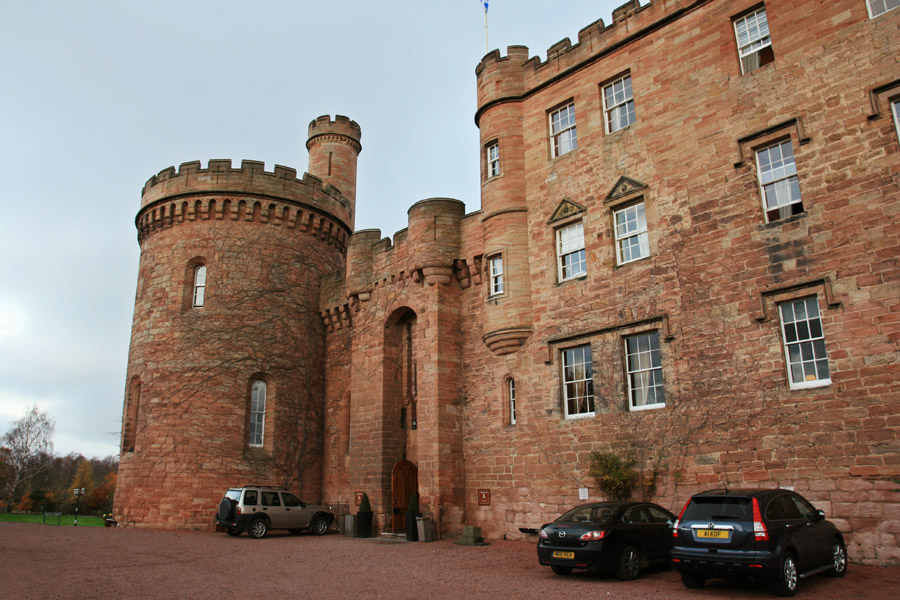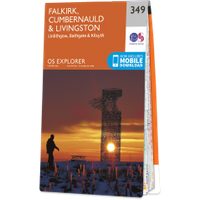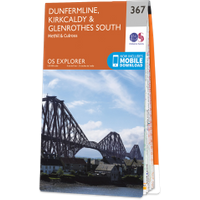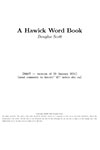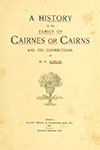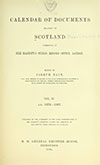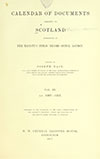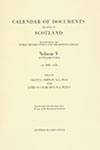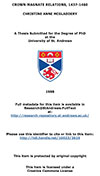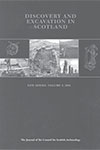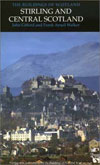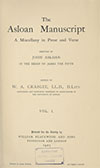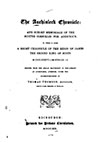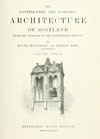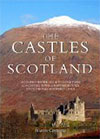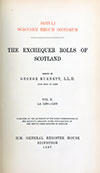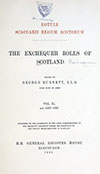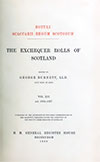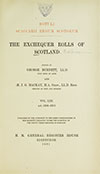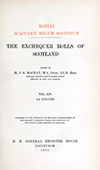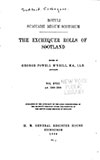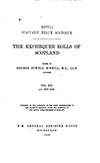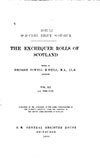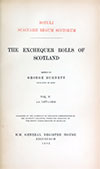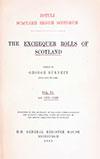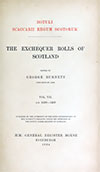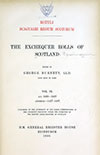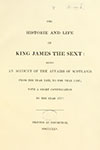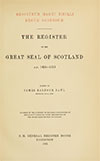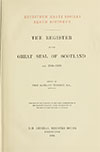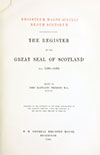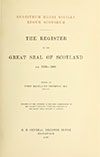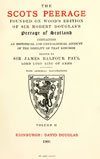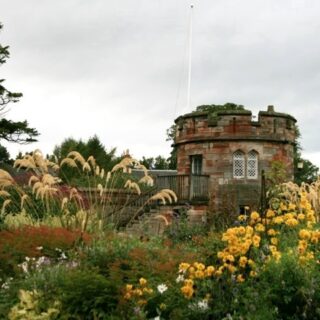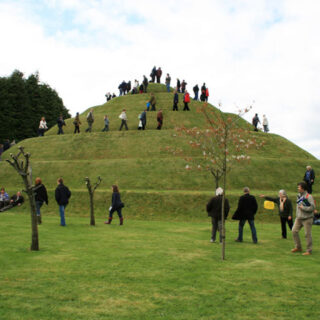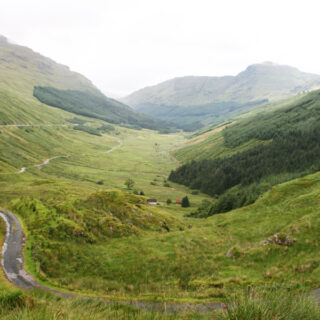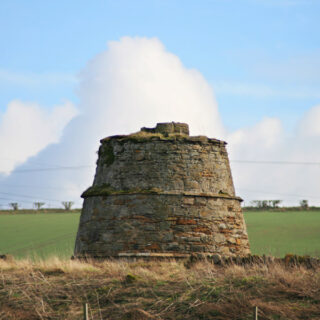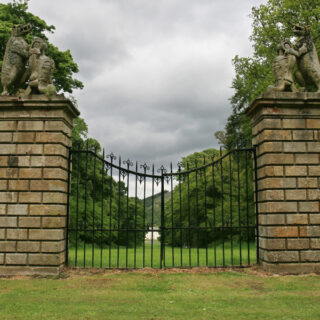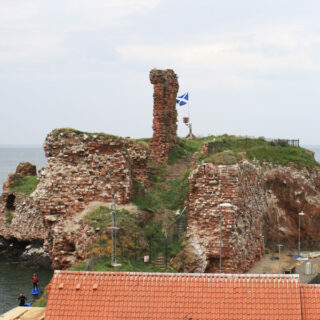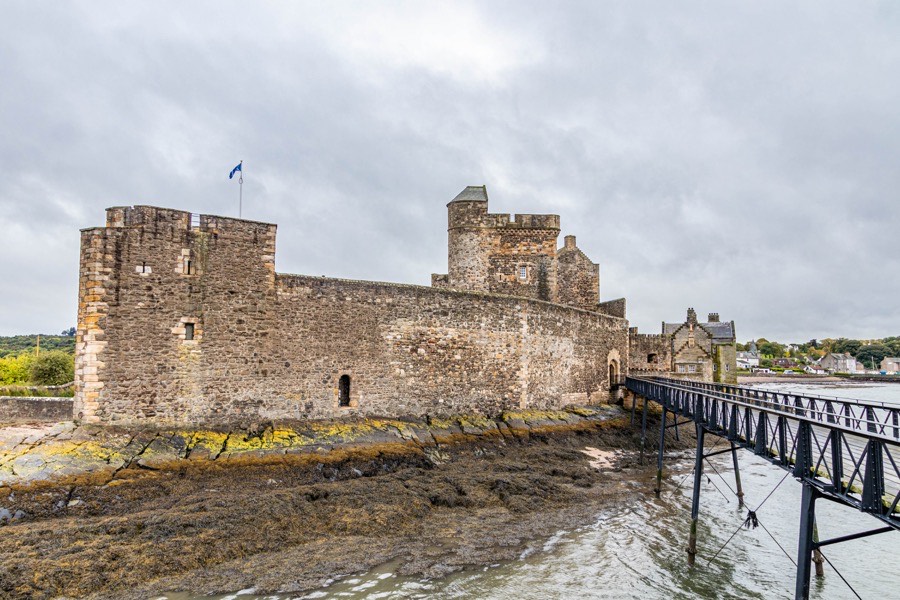

Blackness Castle is a 15th century courtyard castle which was once a royal fortress.
The Vieuxpont, Veteriponte or Vipont family held the lands from the 12th century along with the neighbouring lands of Carriden and in the late 12th century William de Vieuxpont granted coal from Kareddin and ten shillings from all the ships and boats loaded and unloaded in his land of Blackenis to Holyrood Abbey.
Blackness was the site of a port from a very early time, possibly dating back to the Roman period. In the 12th century it served as the port for the newly-created royal burgh of Linlithgow and its castle. During the English occupation of Scotland in the early 14th century supplies were shipped there for the English forces.
It seems inconceivable that such an important port, apparently the only natural harbour between the River Avon beyond Bo’ness to the west and South Queensferry to the east, wasn’t protected by a defensive structure of some kind however there is no explicit evidence of an early castle here.
In 1312 Hugonis de Blakenesse was an archer with the English garrison of Edinburgh Castle. A Hugh de Vepount is on record in England in 1327.
Later in the 14th century Sir William Douglas, Lord of Liddesdale, seems to have owned the lands of Blackness as in 1336 “Abrahe del Blaknes” held the lands of Blackness that William de Douglas had forfeited. Douglas in fact forfeited two thirds of the lands of Blackness with the third part being held in liferent by his mother, Johanna, widow of Sir James Douglas of Hermiston and Lothian.
In 1337 the six acres of land in Blaknes which belonged to Abraham were held by the King due to the minority of Abraham’s heir, Hugh de Vepount. This might suggest that apart from when they were held by Douglas the lands of Blackness continued to be owned by the Viponts into the 14th century.
The lordship of Blackness was granted by James I in the 1430s to Sir George Crichton, Lord High Admiral of Scotland and later 1st Earl of Caithness. Sir George was the son of Stephen Crichton of Cairns. The identity of Sir George’s mother is not known however it is tempting to speculate that she might have been a Vieuxpont heiress.
Following the murder of James I in 1437 Sir George’s cousin, Sir William Crichton, Lord Chancellor from 1439, Sir Alexander Livingston of Callendar and the Douglas family were all vying for influence over the infant James II, a competition which ultimately led to the infamous Black Dinner of 1440 at Edinburgh Castle.
Like his father before him Sir George served as sheriff of Linlithgow and he is said to have started building the first castle at Blackness around 1440. In 1441 as Sir George Crichton of Blackness he witnessed a charter to Sir Alexander Seton of Gordon.
In 1443 Livingston formed an alliance with William Douglas, 8th Earl of Douglas, and the following year Douglas attacked and burnt another Crichton property, Barnton Tower. It has been speculated that the construction of Blackness may have begun following the destruction of Barnton.
However Douglas burnt Sir George’s “blak nestis” in retaliation for Sir George burning Douglas’ “grangis of Abercorne & Strabrok & uther five placis”. It therefore seems more likely that from 1444 Sir George rebuilt and remodelled an earlier castle.
The site was of strategic importance given the royal residence of Linlithgow Palace around 4km inland, and also its position between the two Black Douglas strongholds of Abercorn and Inveravon.
The castle was built almost at sea level on a rocky promontory called the Black Ness which juts out into the River Forth, affording good views up and down the Firth of Forth and across to the north shore. The promontory was separated from the land by a rock-cut ditch which was filled with water, with a salt marsh beyond the ditch to the south giving further protection on the landward side.
The central tower, north tower and courtyard walls are the oldest surviving parts of the castle and are built from dark brown whinstone rubble with lighter sandstone dressings. The courtyard walls, which measure around 1.5m thick, were originally crenellated but were later heightened and remodelled. They resemble the shape of a ship which has led to its nickname of “the ship that never sailed”, with the central tower referred to as the “main mast”, the north tower as the “stem” at the prow and the south tower as the “stern”.
A rock-cut ditch was dug around the courtyard walls on the south and east sides. Towards the south end of the east wall was the original entrance through an arched gateway which would have been reached by a wooden bridge spanning the ditch.
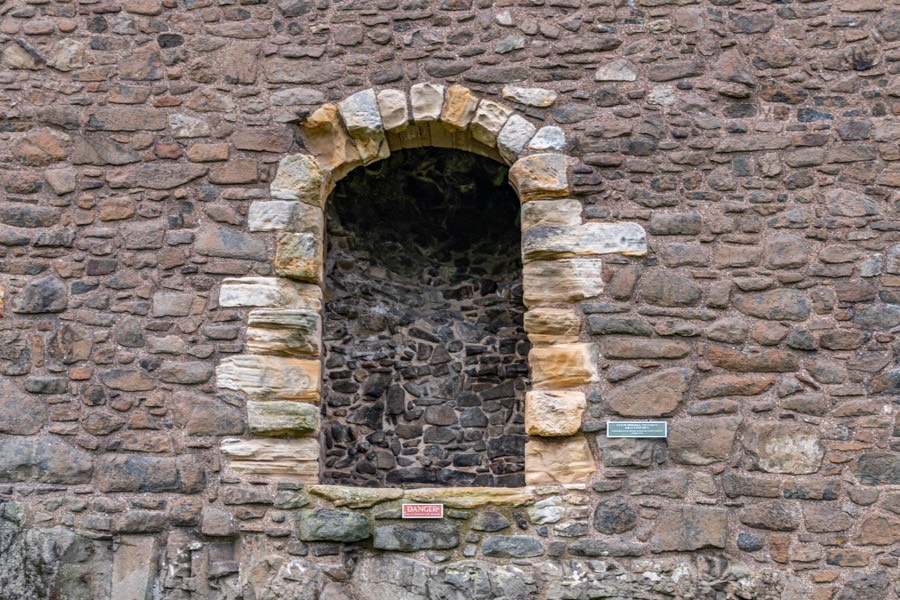

On the north side of the entrance passage through the thickness of the wall was a doorway which would have led into a narrow spiral staircase within the north-east corner of the tower. Each of the subsequent three storeys contains a single room with fireplace, latrine closet, and numerous intramural chambers. The roof was supported on a stone vault and there may have been loft storage on a timber floor just below it.
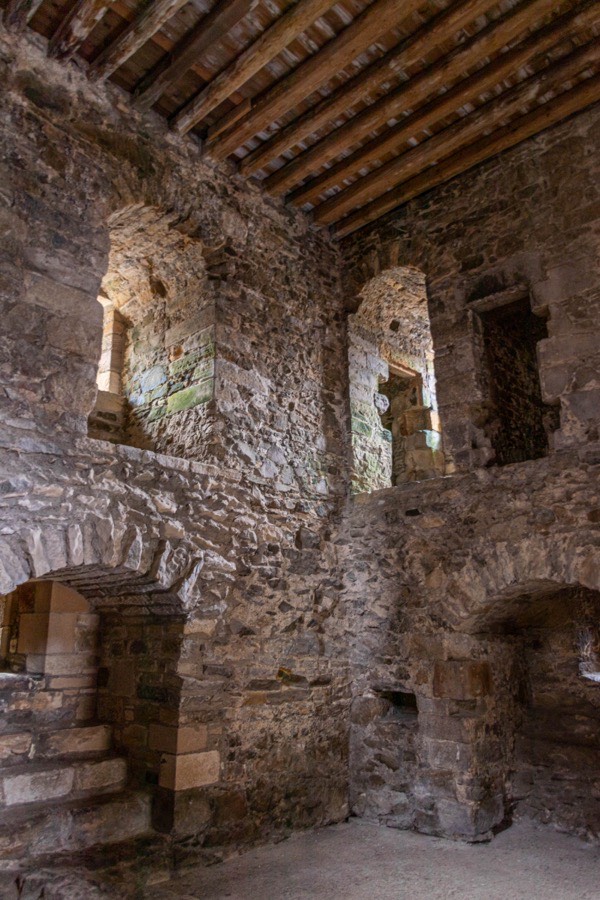
The north tower was originally three storeys in height and is triangular on plan. The entrance is at first floor level, which would have been accessed by an external stair, and leads into a vaulted chamber. Near the north end of the chamber is a hatch in the floor which gives access to a pit-prison below. The pit-prison features a drain which is washed by the sea at high tide. The second floor of the tower is accessed via an entrance from the west wall walk. The original third storey was repurposed as a gun platform in the late 17th century.
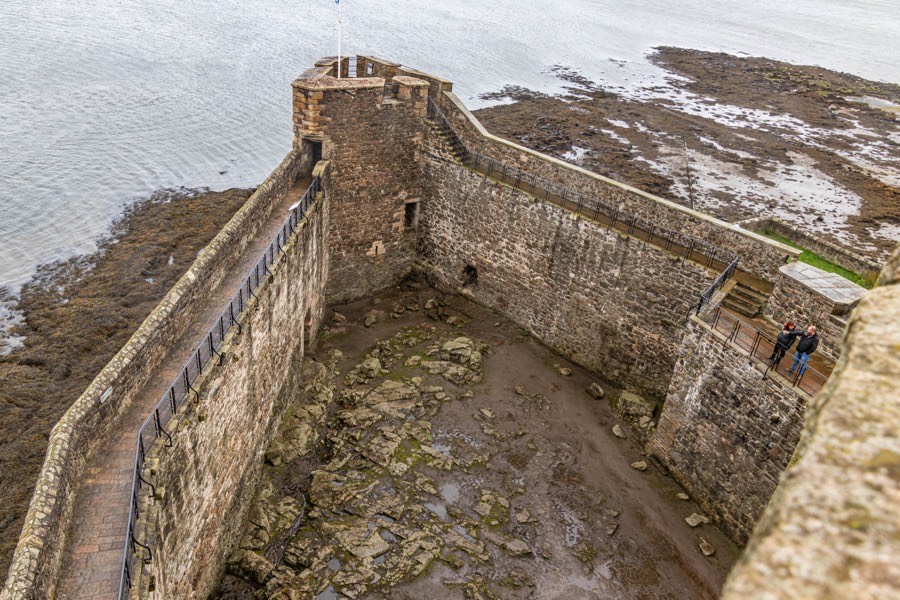
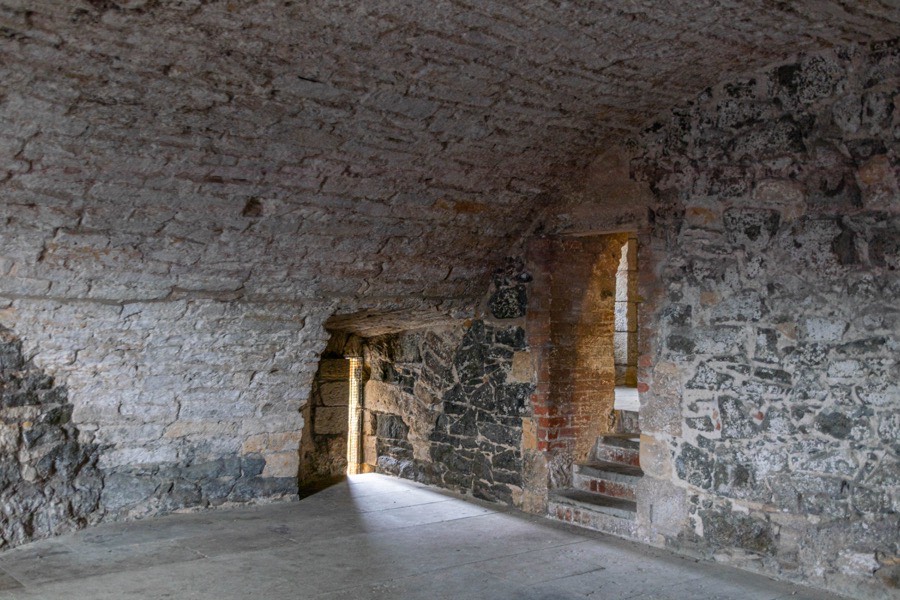
In 1452 Sir George was created Earl of Caithness and the barony of “Rochenes, alias Blaknes” was incorporated, along with various other properties, into the earldom. Interestingly the earldom was to descend to Sir George’s assignee rather than to his heir. The following year Sir George nominated the King as his assignee, presumably under pressure from the King, so disinheriting his son, James Crichton. James attacked and captured the castle and imprisoned his father for 9 or 10 days until the King forced him to surrender, after which Blackness Castle was annexed by the Crown.
James II only inherited the lands which Sir George had acquired during his lifetime and so James Crichton inherited the family estate of Cairns. To further placate James the King also granted him Strathord in Perthshire which had formerly been granted to his queen, Mary of Guelders, in her dowry as part of the barony of Ragortoun (now Redgorton).
In 1465 James III granted the castle along with the chapel of St Ninian, located to the south-west of the castle on the coast at the east end of Blackness village, to the Burgh of Linlithgow which was permitted to take stone and lime from the castle for the construction of a harbour. The castle was later taken back by the the Crown.
In the same year Sir John Ross of Halkhed was the keeper of the castle, a position he held until 1488.
The village of Blackness was burned by an English fleet that sailed up the Forth in 1481 and while the castle was attacked it held out.
James III’s reign was an unpopular one and for much of it he was involved in various conflicts with nobles and also his brother, Alexander Stewart, Duke of Albany. In May 1488 James sailed from Aberdeen to Blackness and stayed in the castle, arranging to meet a faction of rebel lords nearby with a retinue including John Stewart, 1st Earl of Atholl, George Gordon, 2nd Earl of Huntly, William Hay, 3rd Earl of Erroll, David Lindsay, 5th Earl of Crawford and later 1st Duke of Montrose, David Lindsay, 2nd Lord Lindsay of the Byres, and William Ruthven, 1st Lord Ruthven. The meeting turned violent however and led to an indecisive skirmish, sometimes referred to as the Battle of Blackness, with the King and his supporters fleeing to the safety of the castle.
James was later killed at the Battle of Sauchieburn on the 11th of June 1488. In the same month James III’s son and successor, James IV, made Sir William Knollys, Preceptor of Torphichen, the custodian of the castle of Blaknes and sheriff of Linlithgow. Two years later Sir William, by now Lord St. John of Torphichen, was confirmed again in those positions.
James IV stayed at the castle in 1491 and in 1498 confirmed Sir Patrick Hamilton of Kincavil and his heirs as sheriff of Linlithgow and custodian of the castle of Blaknes. Sir Patrick was paid extra in 1517 because of the number of prisoners housed in the castle.
Following Sir Patrick’s death in 1520 during an insurrection by Archibald Douglas, 6th Earl of Angus, the position of Captain and Keeper of Blackness Castle remained with the Hamiltons although different sources give slightly different timelines. One version states that he was succeeded by his brother, James Hamilton, 1st Earl of Arran, who died in 1529. The Earl of Arran is then said to have been succeeded by his eldest but illegitimate son, Sir James Hamilton of Finnart.
Another version has it that Sir Patrick was succeeded by his son, James Hamilton of Kincavil who was forfeited for heresy in 1534 and succeeded by his cousin, Sir James Hamilton of Finnart.
Whichever scenario is correct Sir James Hamilton of Finnart became Keeper of the castle and it was under his guardianship that major work was carried out to convert the castle into a state prison and artillery fortification, commencing according to various sources in either 1535, 1536 or 1537. Sir James was a second cousin of James V and a skilled architect, having been appointed Steward of the Royal Household and the King’s Master of Works. He was responsible for work on several Royal residences.
The curtain wall was significantly thickened to 5.5m across on the east and south sides to withstand bombardment from the increasingly powerful cannons of the day, and also to create sufficient width and strength to support cannons on the battlements. Large gunports were added at ground level in the basement of the south tower and along the east wall. Up to 0.4m wide at the throat and up to 1.5m wide at the mouth, they protected the approach from the south and east.
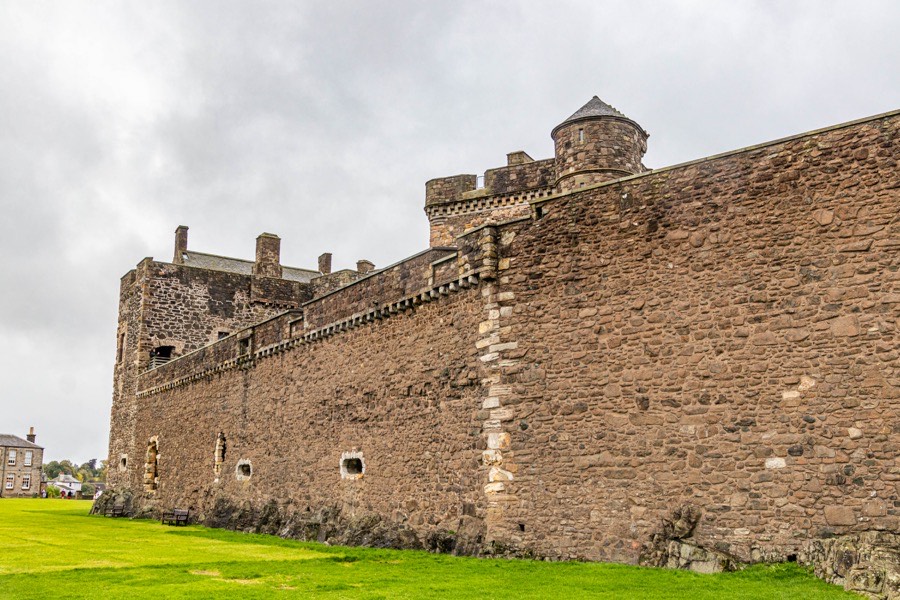
Sir James was responsible for building the only other known examples in Scotland at his own Craignethan Castle and at Tantallon Castle.
The main tower was converted into a prison and the south hall was heightened to form accommodation for the castle’s keeper. The old crenellations can still just be seen just over halfway up the tower incorporated into the later masonry. The basement storage chambers were converted into artillery positions and given the aforementioned large gunports. A large segmental-arched window was constructed in the south wall of the new floor. Although this decorative architectural detail featured stone window seats it also doubled up as a gun emplacement.
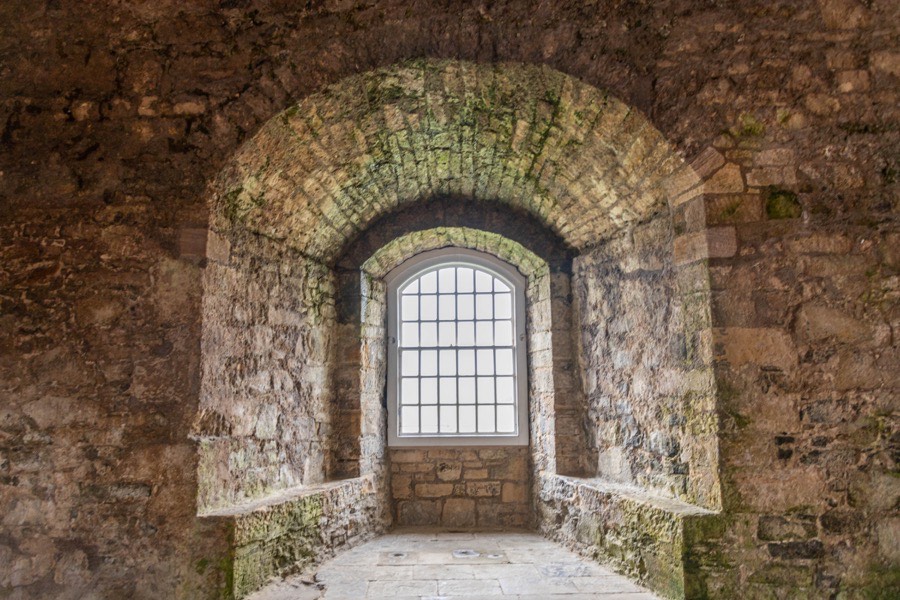
In 1543 Cardinal David Beaton was imprisoned in the castle for a month. He was one of the main rivals of the James Hamilton, 2nd Earl of Arran, a Regent of Scotland during Mary Queen of Scots’ minority. In the same year Sir Ralph Sadler, English ambassador, may have visited the castle and later told Henry VIII of England that Blackness was impregnable.
Work on the castle was finally completed in 1543 or 1544 and in that latter year the 6th Earl of Angus was imprisoned there following a conflict with the 2nd Earl of Arran.
During the Rough Wooing of the mid-16th century the castle served as the main ammunition depot for the combined Scottish and French forces. In 1547 an English fleet under the command of Edward Clinton, Lord Clinton, later 1st Earl of Lincoln, was sent to lay siege to Haddington. As part of the same campaign Clinton’s forces burnt or captured ten Scottish ships moored off Blackness Castle and attacked Luffness Castle.
In 1548 Henry II of France agreed to a military intervention in Scotland under certain terms which included Dunbar Castle and Blackness Castle being garrisoned by French troops.
Further work on the castle was carried out between 1542 and 1567. In 1553 the main tower was heightened and given a corbelled parapet with angle turrets. The caponier was heightened by another storey to further defend the main gate and given the name the Spur.
The south tower, which became known as the Governor’s House, was heightened to four storeys plus a crow-stepped garret, with a hall on the first floor. It was also extended on an L-plan with the addition of an obtusely-angled north-west wing with access to the upper floors of both wings provided by a spiral staircase in the re-entrant angle.
In 1561 the notorious Border Reiver “Crukit Dande” Ormiston was imprisoned in the castle. This was presumably Sir James Ormiston of Ormiston, known as Black Ormiston, who carried letters between representatives of Scotland, England and France on behalf of the 2nd Earl of Arran in 1560. He persistently broke the law throughout the 1550s and was later implicated in the murders of David Rizzio and Henry Stuart, Lord Darnley.
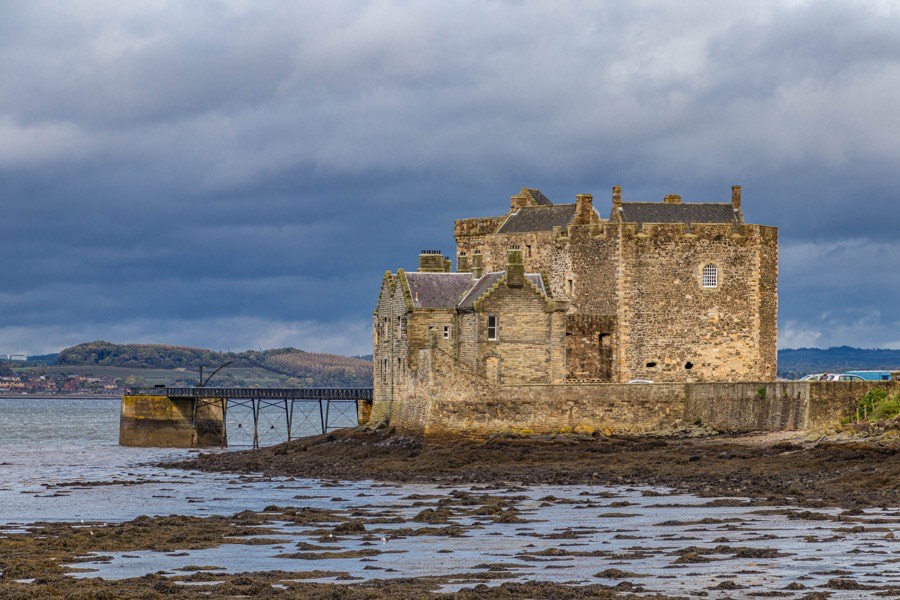
In 1563 and 1567 James Hamilton of Kincavil is listed as the captain of the castle however by the early 1570s the post was occupied by Alexander Stewart. He changed sides and lent his support to the Regent Moray, James Stewart, 1st Earl of Moray, but in 1572, Sir Claud Hamilton recaptured the castle for Mary.
In January the following year James Kirkcaldy, brother of William Kirkcaldy of Grange, arrived at Blackness from France with weapons and money, however his ship was captured and the Regent Morton, James Douglas, 4th Earl of Morton, laid siege to the castle which surrendered within a week. The castle seems to have been retaken by Mary’s supporters once more however as they finally surrendered in 1573 when Edinburgh Castle fell after the Lang Siege.
In 1577 the young James VI confirmed a charter by James Hamilton de Levingstoun to James Douglas, 4th Earl of Morton, Regent of Scotland, giving him the hereditary positions of sheriff of Linlithgow and custodian of the castle of Blaknes. Later that year the Regent Morton imprisoned John Maxwell, 8th Lord Maxwell and the son of Morton’s sister-in-law, at the castle .
Towards the end of 1580 the Regent Morton was accused of complicity in the murder of Lord Darnley, found guilty and executed in 1581. The captainship of Blackness had already reverted to Alexander Stewart in 1580.
In 1584 the religious reformer Andrew Melville was ordered to be imprisoned at the castle on a charge of treason in a sermon he preached in 1583 but he may have escaped to England with the help of friends before he could be taken to Blackness.
John Donaldson, a burgess of Stirling, was imprisoned at Blackness in 1588 for cutting down trees in the royal forest of Torwood without permission.
In the same year James VI granted lands of Bonytoun and Blaknes to James Durham of Duntarvie. These lands were traditionally held by the keeper of Blackness Castle so it seems likely that Durham had been appointed to that position. A charter of the same lands was confirmed to Durham in 1591. A doocot which once stood on raised ground to the south of the castle once had a carved panel with the date of 1591.
In 1592 the King appointed Sir James Sandilands of Slamannane as captain of the castle and granted him the coal and charcoal from the lands of Bonyngtoun and Blaknes. He was confirmed in the position in 1595. Sandilands was acquainted with the former keeper Alexander Stewart’s son, Sir Alexander Stewart of Newtounleys, who was shot dead in Leith Wynd in Edinburgh when Sandilands killed John Graham of Hallyards.
Sandilands resigned the captaincy of the castle in 1598 and it was granted by the King to Alexander Livingston, 7th Lord Livingston and later 1st Earl of Linlithgow. In 1604 Livingston’s brother-in-law, Patrick Stewart, 2nd Earl of Orkney, was ordered to appear at Blackness for imprisonment but failed to do so and was charged with treason.
The following year Gilbert Brown of Carsluith (sometimes referred to as Gilbert Broun), the last abbot of the abbey of New Abbey (also known as Sweetheart Abbey), was imprisoned at Blackness before being moved a few days later to Edinburgh Castle.
In 1606 James VI gave William Maxwell, son of Edward Maxwell of Tinwald, a letter of release freeing him from imprisonment in Blackness Castle. The document suggests that Maxwell had been imprisoned since 1597.
The 1st Earl of Linlithgow died in 1621 and was presumably succeeded as keeper of Blackness by his son, Alexander Livingston, 2nd Earl of Linlithgow and 8th Lord Livingston, as in 1640 the 2nd Earl is on record resigning his positions as constable and keeper of Linlithgow Palace and Blackness Castle in favour of his son, George Livingston. The 2nd Earl died in 1648 and George succeeded his father as 3rd Earl of Linlithgow and 9th Lord Livingston.
The 7th Lord Livingston resigned his positions as constable and keeper of Linlithgow Palace and Blackness Castle in favour of his son, George Livingston, later 3rd Earl of Linlithgow and 8th Lord Livingston.
Sir George Stirling of Keir was imprisoned in the castle in 1645. He served on the Committee of Estates so it may have been for something related to Covenanting.
The courtyard wall was further strengthened in the 17th century for defence against artillery however following the English invasion of Scotland Blackness Castle was captured by General Monck in 1651 after being bombarded from land and sea, including from the rise on which the doocot stands. The castle wasn’t repaired until 1660 after which it was again used as a prison. The lighter stone used for the repairs is evident on the lower section of the south tower’s south wall in particular.
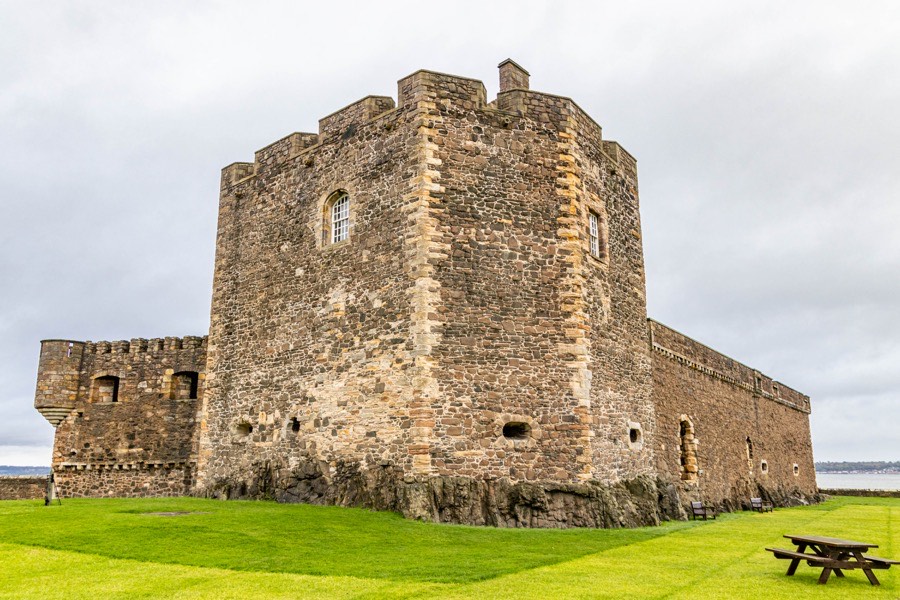
In 1667 a spiral stair tower was added to the main tower’s north-east corner to improve access to the upper floors. The original entrance into the tower on the east wall was blocked at this time and converted into a window, with a new entrance at the bottom of the stair tower. The south tower was converted into barracks, and the square stair tower in the re-entrant angle may also date to this period, replacing an earlier stair tower.
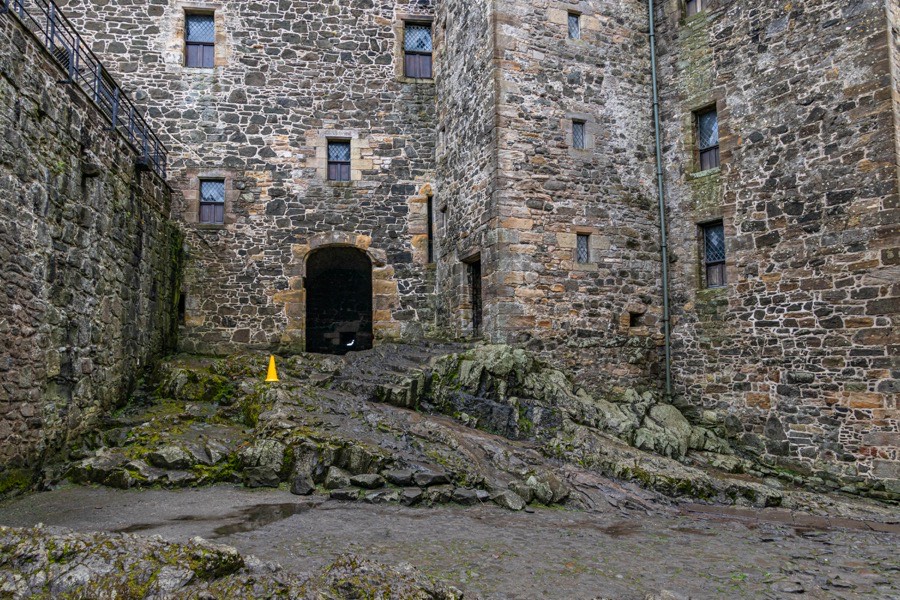
In November 1679 John Hamilton, 2nd Lord Lord Bargany, was imprisoned in the castle having been accused by his Ayrshire neighbour James Crawfuird of Ardmillan of being a traitor. The accusation was false however, Crawfuird’s motivation being Lord Bargany’ intent to reveal that Crafuird had been taking bribes from the Covenanters he was supposed to be hunting down and imprisoning.
John Hay of Park and Lochloy was in 1683 imprisoned for thirteen months, partly in the tolbooth in Edinburgh and partly in Blackness Castle, for failing to pay off his creditors.
The garrison of Blackness Castle comprised of 41 men in 1691 when the castle was used to imprison opponents of William and Mary. In 1693 Captain William Erskine was described as lieutenant governor of Blackness. That year the Spur was heightened further when it was altered for use as a gun platform, had a wall walk constructed and an angle turret added at the south-west corner. The iron yett at the main entrance also dates from this time.
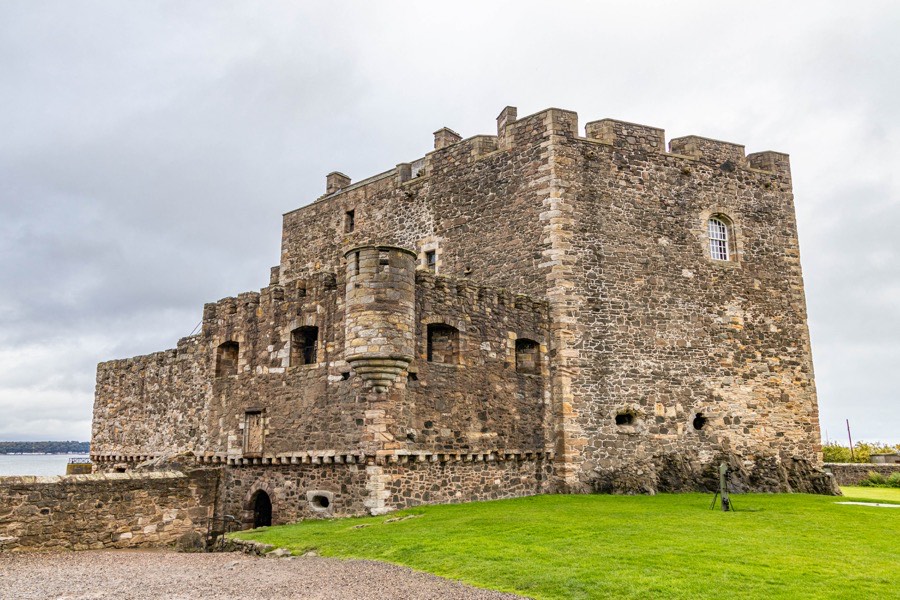
In 1699 Sir David Colyear, eldest son of Sir Alexander Robertson of Strowan, was created Lord Portmore and Blackness for his service to William of Orange in Ireland.
Blackness was one of four castles in Scotland, along with Dumbarton, Stirling and Edinburgh, that was guaranteed to be maintained according to the Acts of Union of 1707, aiming to protect the Lowlands from any possible incursions south by Highlanders.
In the same year Blackness Castle became a military base rather than a state prison and served variously as a barracks, prison and storage depot over the following years. The central and south towers were converted into barracks and the gun ports in the south tower were blocked up and converted into bread ovens.
During the 18th and 19th century the castle was used to as a transit camp for prisoners of war from the conflicts with France, Spain and America.
In 1868 a pier was built giving direct access to the courtyard via a drawbridge and gateway cut through the west wall, destroying a 16th century guardhouse in the process.
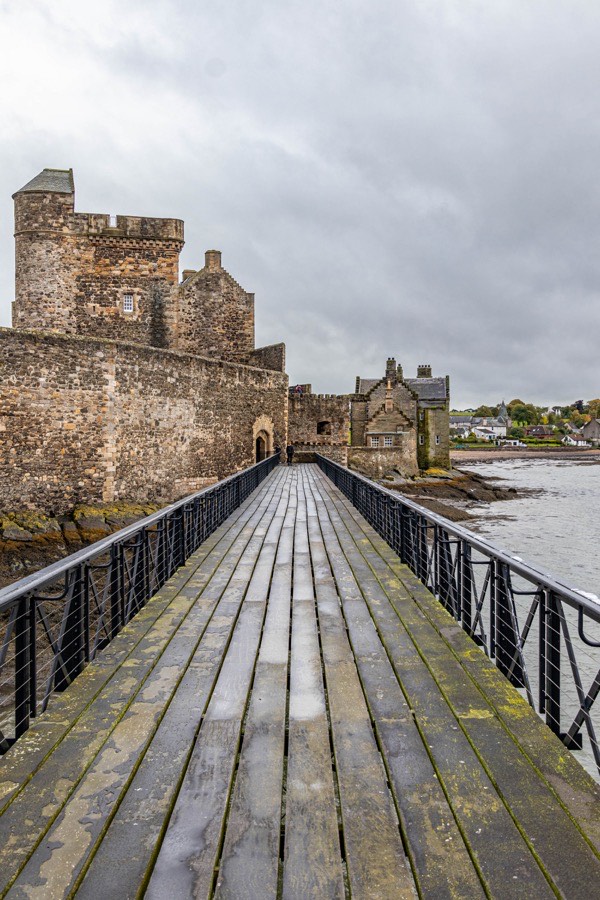
Land was reclaimed to the east of the castle for the construction of further military buildings and a new wide entrance was knocked through the east courtyard wall. The courtyard between the central and south towers was given a roof of concrete and steel and the ditch to the south of the castle was filled in and a water cistern installed.
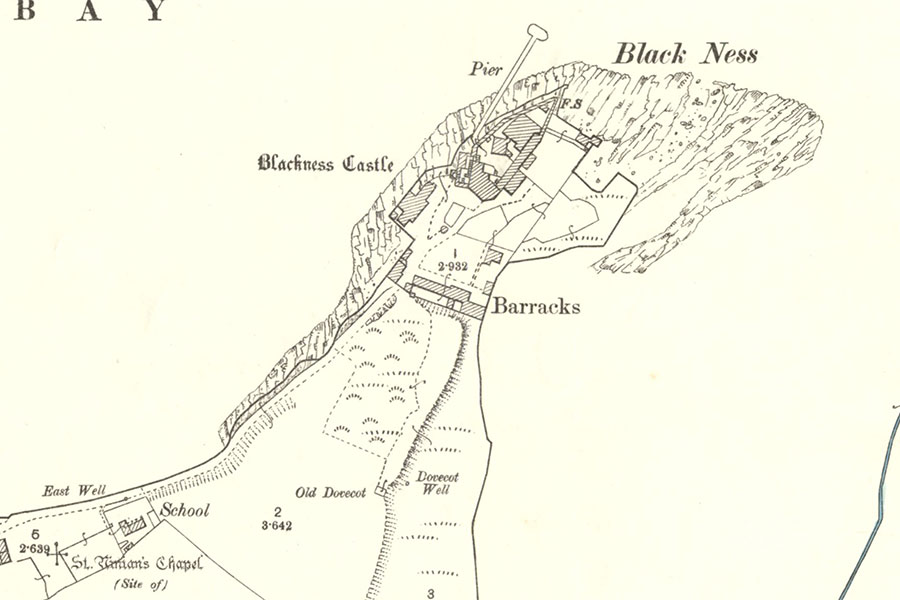
Ordnance Survey, 1896map image courtesy of NLS
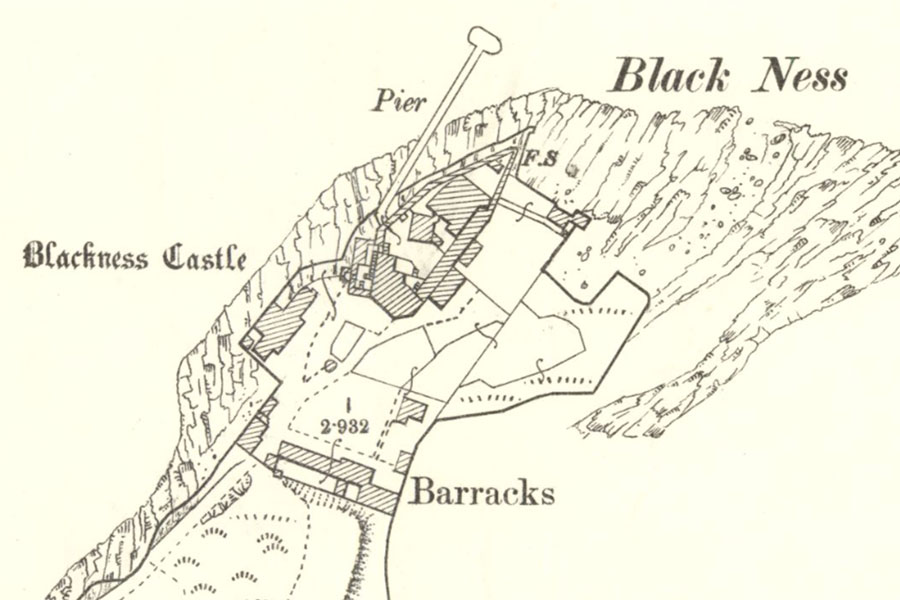
Ordnance Survey, 1896map image courtesy of NLS
In 1912 the War Office handed the castle over to the Office of Works however upon the outbreak of World War I it was re-occupied by the army and garrisoned until 1919 when it returned to state guardianship.
An extensive programme of restoration was undertaken between 1926 and 1935. Most of the Victorian additions were removed with the exception of the new barrack block and officers’ block to the south of the castle’s walls. The land to the east of the castle was cleared of all buildings, the new entrance in the east courtyard wall was removed and the wall rebuilt, and the courtyard roof removed. The original 15th century east entrance was opened up at this time to its depth of around 1.5m but remains blocked due to the 16th century thickening of the interior of the curtain wall beyond.
During the restoration work an iron manacle was discovered in the pit-prison still clasped around the wrist bones of an unfortunate prisoner.
Around 1930 the south tower’s battlements were “restored” to their current form, and the restoration of the main tower’s angle turrets, battlements and corner stair tower roof also date to this time.
Today the castle is operated as a visitor attraction by Historic Scotland.
Legend has it that there is a secret underground tunnel stretching all the way from Blackness Castle to the House of the Binns, some 1.7km to the south.
Alternative names for Blackness Castle
Blackenasse; Blackenay; Blackenis; Blacknes; Blacknes'; Blacknestes; Blackynes; Blacnes; Blak Nestis; Blakenes; Blakenesse; Blaknes; Blaknes'; Blakness; Blaknesse; Roche-nes; Rochenes
